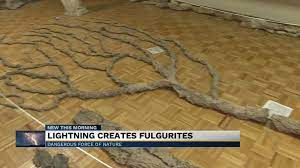Grumblenuts
Gold Member
- Oct 16, 2017
- 15,428
- 5,223
- 210
To understand electricity is to understand nature. Studying fulgurites helps one better understand electricity.




That's where lightning contacts the Earth. But wait, there's more..

Fulgurites (from Latin fulgur 'lightning', and -ite), commonly known as "fossilized lightning", are natural tubes, clumps, or masses of sintered, vitrified, and/or fused soil, sand, rock, organic debris and other sediments that sometimes form when lightning discharges into ground.
Fulgurites, sometimes called “petrified lightning” and “lightning stones,” are natural tubes of glass formed by the fusion of silica (quartz) sand or rock from a lightning strike. Their shape mimics the path of the lightning bolt as it hit the ground.



That's where lightning contacts the Earth. But wait, there's more..
Lichtenberg figures:Fulgurites are structurally similar to Lichtenberg figures, which are the branching patterns produced on surfaces of insulators during dielectric breakdown by high-voltage discharges, such as lightning.

J.J. Thompson described what he saw in his cathode ray experiments simply as "corpuscles." Fulgurites are often described as hollow or full of tubular holes. What do you see (in relation to electricity)?Modern 3D Lichtenberg figures or "electrical treeing" in a block of clear acrylic, created by irradiating the block with an electron beam. Actual size: 80 mm × 80 mm × 50 mm (3 in × 3 in × 2 in)
Last edited:
